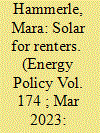| Srl | Item |
| 1 |
ID:
177144


|
|
|
|
|
| Summary/Abstract |
This paper presents the first analysis of how the split incentive market failure affects the implementation of energy efficiency technologies in the maritime transport sector. In maritime transport, split incentives occur due to the different types of charter (resulting in the divided responsibility for fuel costs) existing between shipowners and charterers. The paper uses a robust and rigorous framework of methods to operationalise the split incentive concept in a cross-sectional survey of 275 shipowners, representing around 25% (6000 ships) of the target population, resulting in the most comprehensive data on the implementation of energy efficiency technologies in shipping. The findings show, contrary to that postulated in the literature, that firms that have majority of their ships on time charter (i.e. those that don't directly observe the energy price signal but may potentially receive an energy efficiency premium) have a higher implementation of energy efficiency technologies compared to firms that operate ships on the spot charter (i.e. directly observe the price signal). To some extent the findings could be due to the effect that other confounding variables may have on the implementation of measures and the extent to which the shipping market is correcting or overcoming the split incentive efficiency problem.
|
|
|
|
|
|
|
|
|
|
|
|
|
|
|
|
| 2 |
ID:
191251


|
|
|
|
|
| Summary/Abstract |
Rooftop solar photovoltaic (PV) systems present households with a way to reduce their energy bills, while contributing to a clean energy transition. However, rental properties are considerably less likely to have solar PV. It is unclear whether current policies that focus on reducing upfront costs to installing solar PV address the barriers perceived as most important by property investors. Using a best-worst scaling survey of 931 property investors, we find that investors on average view renters being unwilling to pay higher rents for properties with solar PV equally as important as affordability concerns as barriers to investment. Owners of apartments or townhouses focus on structural barriers. Our discrete choice experiment of 147 property investors shows that policies that spread solar system payments over time and direct feed-in tariff revenue to property investors are not preferred by most owners of fully-detached rental dwellings. We conclude by stressing the importance of policies that reduce information asymmetries from the property investor perspective regarding the value that renters place on PV systems. There is also a need for policies to better address barriers faced by owners of apartments and townhouses.
|
|
|
|
|
|
|
|
|
|
|
|
|
|
|
|
| 3 |
ID:
166405


|
|
|
|
|
| Summary/Abstract |
Improving energy efficiency, de-carbonising heating and cooling, and increasing renewable microgeneration in existing residential buildings, is crucial for meeting social and climate policy objectives. This paper explores the challenges of financing this ‘retrofit’ activity. First, it develops a typology of finance mechanisms for residential retrofit highlighting their key design features, including: the source of capital; the financial instrument(s); the project performance requirements; the point of sale; the nature of the security and underwriting the repayment channel and customer journey. Combining information from interviews and documentary sources, the paper explores how these design features influence the success of the finance mechanisms in different contexts. First, it is shown that a low cost of capital for retrofit finance is critical to the economic viability of whole-house retrofits. Second, by funding non-energy measures such as general improvement works, finance mechanisms can enable broader sources of value that are more highly prized by households. Thirdly, mechanisms that reduce complexity by simplifying the customer journey are likely to achieve much higher levels of uptake. Most importantly we discuss how finance alone is unlikely to be a driver of demand for whole-house retrofit, and so instead should be viewed as a necessary component of a much broader retrofit strategy.
|
|
|
|
|
|
|
|
|
|
|
|
|
|
|
|